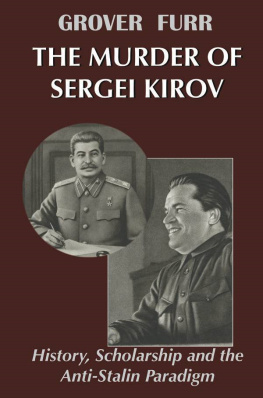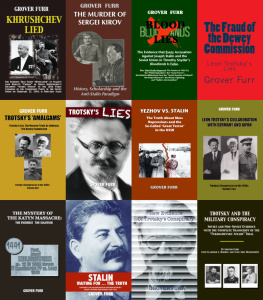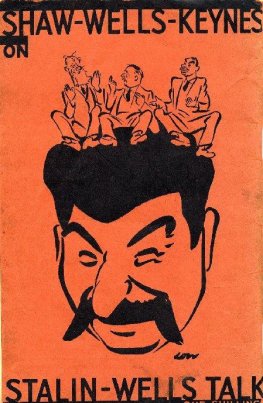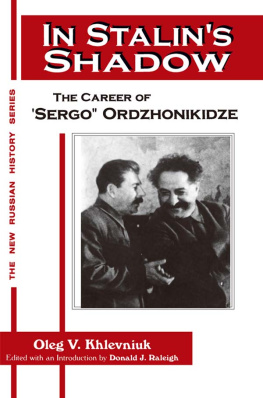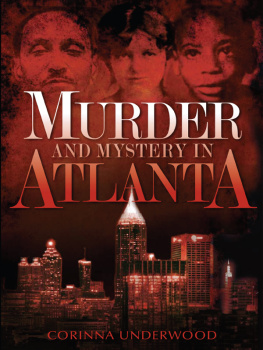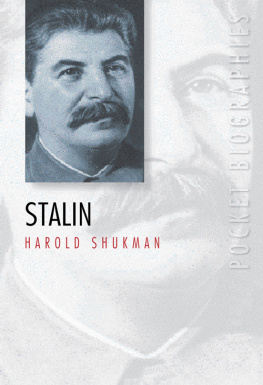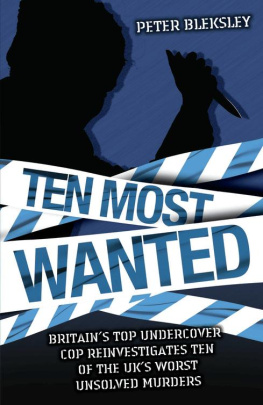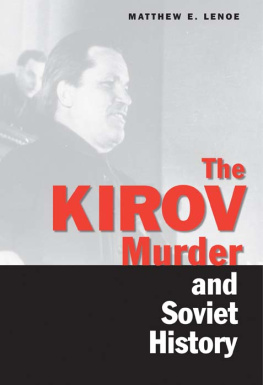The Murder of Sergei Kirov
History, Scholarship and the
Anti-Stalin Paradigm
By Grover Furr
Erythros Press and Media, LLC
Corrected Edition, November 2013
The Murder of Sergei Kirov: History, Scholarship and the Anti-Stalin Paradigm
First English Edition 2013
Published in Russian by lzdatel'skii Dom "Russkaia Panorama" in 2013 under the title Ubiystvo Kirova. Nove rassledovanie.
Published by
Erythros Press and Media, LLC
PO Box 291994
Kettering, Ohio 45429-0994 USA
Grover Furr 2012, 2013
Published and printed with permission of the author, who assumes all responsibility for the content herein.
Locally Assigned LC-type Call Number
Furr, Grover C. (Grover Carr)
The Murder of Sergei Kirov: History, Scholarship and the Anti-Stalin Paradigm / Grover C. Furr; translations by Grover C. Furr
ISBN: 978-0-615-80201-5
434 p. Includes index.
1. Kirov, Sergei Mironovich, 1886-1934. 2. Revolutionaries - Soviet Union. 3. Stalin, Joseph, 1879-1953. 4. Soviet Union - Politics and government - 1917-1936. 5. Soviet Union - Politics and government - 1936- 1953. 6. Soviet Union - Politics and government - 1953-1985. 7. Russia - Politics and government. I. Title.
Table of Contents
Acknowledgements and Dedication 1
List of Abbreviations 2
Introduction 3
Chapter 1 . Kirilina. 13
Chapter 2. Lenoe's Introduction. 32
Chapter 3. Lenoe's Errors. 47
Chapter 4. Fallacies and Errors in Lenoe's Argumentation. 77
Chapter 5. Lenoe and the Fallacy of 'Begging the Question' 101
Chapter 6. The Leningrad and Moscow Centers. 114
Chapter 7. The Bloc of Rights and Trotskyites. 131
Chapter 8. Nikolaev's First Confession. 142
Chapter 9. Stalin's Remark to "Target the Zinovievites" 161
Chapter 10. Iurii Sedov, "Reliable Researcher'' 183
Chapter 11. Documents Lenoe Ignores. 191
Chapter 12. Evidence Lenoe Ignores: Kirov Murder to 1936 Trial. 218
Chapter 13. Evidence Lenoe Ignores - The First Moscow Trial. 236
Chapter 14. Evidence Lenoe Ignores - The Second and Third Moscow Trials. 260
Chapter 15. Iagoda's Confession. 283
Chapter 16. Bukharin and Kotolynov. 315
Chapter 17 Liushkov's Essay. 336
Chapter 18. Enukidze and the "Lone Gunman" Story. 359
Chapter 19. Osmund Egge. 374
Chapter 20. Conclusion: The Logic of the Evidence. 396
Appendix One - The Issue of Torture. 409
Appendix Two - Texts of Primary Documents Ignored by All Previous Writers. 422
Bibliography and Sources 424
Index 425
Acknowledgements and Dedication
Once again, I would like to express my continuing gratitude to Kevin Prendergast and Arthur Hudson, Inter-Library Loan librarians at Harry S. Sprague Library, Montclair State University.
Their tireless efforts to obtain hard-to-find articles and books in many languages make my research possible.
*****
I dedicate this book to Susana Magdalena Sotillo, Ph.D., dedicated scholar and teacher, incisive and supportive critic, mi companera ymi camarada, with all my love and respect.
Without your encouragement and support this work would never have been undertaken.
List of Abbreviations
Egge: Egge, Osmund. Zagadka Kirova. Ubiystvo, razviazavshee stalinskii terror. Moscow: ROSSPEN, 2011.
Kirilina: Kirilina, Alla. Neizvestnyi Kirov. St Petersburg: "Neva"; Moscow: "Olma-Press", 2001.
Lenoe: Lenoe, Matthew. The Kirov Murder and Soviet History. New Haven: Yale U.P. 2010.
Lubianka 1922-1936: Lubianka. Stalin i VChK-GPU - OGPU-NKVD. IAnvar' 1922 -dekabr' 1936. Moscow: IDF, 2003
Lubianka 1937-1938: Lubianka. Stalin i Glavnoe Upravlenie Gosbezopasnosti NKVD. 1937-1938. Moscow: "Materik", 2004.
RKEB 1: Reabilitatsiia: Kak Eto Bylo. Mart 1953 -Fevral' 1956 gg. Dokumenry Prezjdiuma TsK KPSS i Drugie Materialy. Moscow: Mezhdunarodniy Fond "Demokratiia", 2000.
RKEB 2: Reabilitatsiia. Kak Eto Bylo. Febral' 1956 - nachalo 80-kh godov. T.2. Moscow: "Materik", 2003.
RKEB 3: Reabilitatsiia. Kak Eto Bylo. Seredina 80-kh godov - 1991. Dokumenry. T.3. Moscow: "Materik", 2004.
R-PP: Reabilitatsia: Politicheskie Protsessy 30-x -50-x gg. Moscow: Izda tel'stvo politicheskoi literatury, 1991.
Introduction.
The basic facts have never been seriously disputed. At about 4:30 p.m. on December 1, 1934 Sergei Mironovich Kirov, First Secretary of the All Union Communist Party (Bolshevik) of Leningrad oblast' (province) and city, entered the Smolny Institute, headquarters of the Bolshevik Party. Kirov mounted the stairs and walked along the corridor of the third floor towards his office. Leonid Vasil'evich Nikolaev, an unemployed Party member, was standing in the hallway. Nikolaev allowed Kirov to pass by and then rushed towards him from behind, took out a pistol, and shot Kirov in the back of the skull. Nikolaev then tried to shoot himself in the head but missed and fell in a faint on the floor a few feet from Kirov's body.
In Russian the Party's title was ''VKP(b)" (Vsesoiuznaia Kommunisticheskaia Partiia (bolshevikov), or "All-Union Communist Party (bolshevik)"; informally, it was still referred to as the "Bolshevik Party'', ''Bolsheviks", etc.
Nikolaev was seized on the spot. From this point on there is little agreement.
Either late that night or sometime the next day his interrogations began. At first Nikolaev seems to have claimed that he had killed Kirov on his own, without any accomplices, in order to draw attention to what he felt was unfair treatment of himself. Within two or three days he began to, hint that others were involved. Before a week was out Nikolaev had admitted that he was part of a conspiracy by a clandestine group of Party members opposed to Joseph Stalin and favoring Grigorii Zinoviev, Leningrad First Secretary before Kirov.
NKVD investigators now turned their attention on this group. Interrogations of those Nikolaev had named, and then of the persons named by those men, led to a number of partial and a few fuller confessions. Three weeks after the murder fourteen men were indicted for conspiracy to kill Kirov. They were tried on December 28-29, convicted, and executed immediately. Meanwhile, Nikolaev's brother Piotr and wife Mil'da Draule had made more and more self-incriminating confessions. In March 1935 Draule was tried, convicted, and executed.
*****
The larger significance of the Kirov murder unfolded only gradually dur ing the next three years. The threads that bound the Kirov conspirators to Zinoviev and Kamenev, followed up by NKVD investigators, led to the three Moscow "Show Trials" of 1936, 1937 and 1938, and to the trial of the military commanders known as the ''Tukhachevsky Affair" of 1937 . This last led in turn to the "Ezhovshchina", also known as the "Great Terror" of 1937-1938, during which some hundreds of thousands of Soviet citizens, most certainly innocent, were arrested and executed, with many others being imprisoned.
On March 5, 1953 Joseph Stalin died. Within months Nikita Khrushchev had become the most powerful leader of the Soviet Union. Before Stalin had been dead many months Khrushchev began organizing a campaign to attack Stalin. A major part of this effort was to declare that Stalin had fabricated false cases against all the defendants of the Moscow Trials and Tukhachevsky Affair.
Khrushchev hinted at these things in his famous "Secret Speech" of Feb ruary 25, 1956. In the same speech he also cast doubt on the official version of the Kirov assassination. Within the party leadership Khrushchev and his men promoted the "rehabilitations" of a great many persons who had been executed during the 1930s, including some of the Moscow Trial defendants . Khrushchev and his men tried hard to find any evidence they could to prove that Stalin had been behind Kirov's murder. But they were unable to do so, and so at length settled for a story that Nikolaev had acted on his own.

